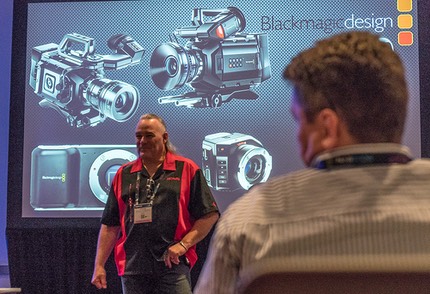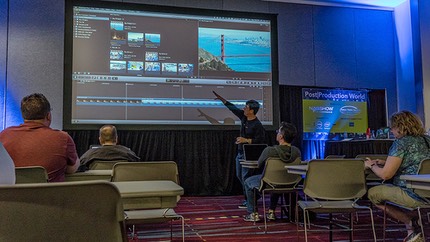April 16
The two days prior to the exhibit floor opening are mostly about seminars, lectures, some keynotes, and special interest track sessions. I use days like these to try to fill in gaps in my knowledge, so generally target the thing I’m weakest at, which for video would be modern post-production.
So I’m over at Post/Production World in the North Hall trying to get my brain filled. Post/Production World started Saturday afternoon and runs through Wednesday, but I won’t have time to attend any sessions after today. I picked two sessions that apply to tools I use: BlackMagic Cinema Camera Workshop and Getting Started with Final Cut Pro X. If you’re curious about the sessions that were available, you can see that at the NAB Web site for Post/Production World.
I attended the BlackMagic session essentially to see if my experience with those cameras matched that of someone using them in production of everything from video to feature films. Still, I learned a couple of new things. But the presenter, Douglas Spotted Eagle, also made a comment in passing that I agree with and every video shooter needs to embrace fully, so I’ll repeat it here: “resolution is less important than the codec.”

Video these days is basically either HD (1080P) or UHD (2160P, or what many call 4K). The numbers tell you how much information you can “resolve” vertically in the 16:9 aspect ratio. There’s currently a big rush towards 4K from HD, but if you’re not careful, this can be a fool’s rush. 4K video that’s achieved by sub-sampling the sensor and then compressed with a harsh codec simply may not look as good as HD achieved by full sensor capture and compressed with ProRes 4.2.2 or better or DnXHD. That becomes especially true if you have to transcode (decompress from one format and re-encode into another), which is what happens most of the time with most of the camera company codecs.
The camera companies have a different goal than you do with compression: they’re trying to minimize cost of parts but provide recording that will keep up with (relatively) inexpensive media and not tax the bandwidth capabilities internally. You just want clean, good looking video. It’s why Nikon’s approach in teaming with Atomos for external recorders isn’t a bad one: the Atomos products record ProRes from the clean signal the Nikon DSLRs provide them.
So, certainly look at the codec in the camera and how the data was obtained and given to it. But look more carefully at your options for doing better than that. I’ll have much more to say about that as we get to the product launches and exhibits, I’m sure.
Meanwhile, you might wonder why I went to a “getting started” session for Final Cut Pro X. After all, I’ve been using FCPX since it came out for my video work. Two words: the instructor.

Steve Martin is one of the principals of RippleTraining. I’ve been watching his podcasts for years now, and know him to be organized, informed, clear, energetic, and deep in his knowledge of Final Cut Pro and Motion. I suspected that even though this was billed as a starting out session, he’d get deep into the product, and fast.
Which is exactly what happened. And about two hours in he answered a question and solved one of my biggest stumbles to date with FCPX: grading individual channels in Multicam. For some reason, virtually all the Multicam training out there gets deep into the editing aspect of it, and leaves out a few critical elements like dealing with differing cameras.
But I learned other stuff, too. More than I thought I would, actually. FCPX is such a rich product with so many different ways to do things—sort of like Photoshop—that it’s tough to be only an occasional user and discover everything it has to offer. Steve also solved a B-roll issue I’d been making more complicated than it need be. And this was in his introductory presentation. He’s got three more “in depth” presentations coming over the next few days and I wish I could be there for them, but unfortunately have appointments out the wazoo to go to.
As you probably already know, I’m a firm believer in life-long learning. Learning is part of the process of how we grow, both as a worker as well as a person. So, my advice to you if you’re ever going to attend an NAB convention in the future: don’t neglect the side sessions and sub-conferences. There are plenty, and some of them are filled with great teachers.
Total distance walked today: 5.17 miles





